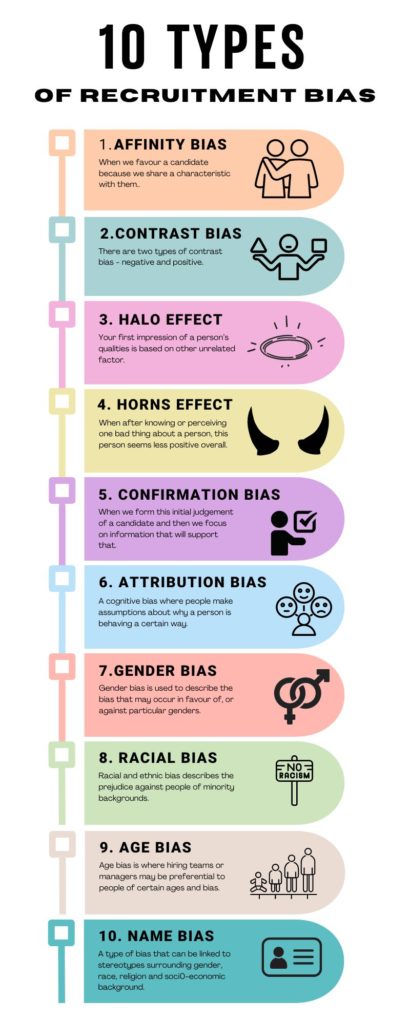Understanding the 10 different types of recruitment bias
Recruitment is an important process for any organisation, aiming to attract, select and hire the best talent. However, despite best intentions biases can creep into the recruitment process, leading to unfair hiring practices and potentially missing out on the best candidates. Recognising these biases is the first step towards mitigating them and ensuring a fairer and more effective recruitment process.

Here are ten different types of recruitment biases that every organisation should be aware of:
Affinity Bias
Affinity bias refers to the unconscious bias where people show preference towards people who they relate to. This could be in relation to many factors, including, but not limited to, preferring people with similar experiences with education, religion, race, gender, economic background, or geographic location.
Confirmation Bias
Confirmation bias refers to the unconscious bias where people gravitate towards information which confirms their pre-existing beliefs. For example, if a hiring manager believes people who prefer flexible working arrangements are lazy, they may be prejudiced against candidates who say they would like flexible working arrangements – even if that candidate is highly qualified for the vacancy and flexible working is available at the hiring company.
Halo Effect
The halo effect describes a bias where a person is viewed positively overall due to one good trait – which may be unrelated to any other traits. For example, an employee might be considered good looking, and this causes their poor performance to be viewed more generously than if they were not considered good looking.
Horns Effect
The horns effect is the opposite of the halo effect, where one negative trait causes a person to be a victim of prejudice. For example, a woman may encounter difficulty attaining a promotion and face patronising attitudes in the workplace despite strong performance due to prejudice against her gender.
Contrast Effect
There are two types of contrast bias – negative contrast bias and positive contrast bias. Negative contrast bias refers to when a skilled candidate is viewed as being less impressive than they truly are as they are going up against over-qualified candidates. Positive contrast bias occurs when a lacklustre candidate appears stronger than they really are because their competition happens to be weaker or lacking.
Attribution Bias
Attribution bias is a cognitive bias where people make assumptions about why a person is behaving in a certain way or an event has gone in a certain direction. It often leads to inaccurate assessments and illogical reasoning.
Gender Bias
Gender bias is used to describe the bias that may occur in favour of, or against, particular genders. For example, many women struggle to break into, progress, or remain in the tech industry due to misogyny. Women also encounter prejudice across a variety of industries, manifesting as the motherhood penalty and gender pay gap. Men may be less likely to face prejudice due to their gender in these areas. Gender bias can sometimes negatively impact men, such as in jobs which are traditionally dominated by women or perceived to be ‘feminine’, such as nursing or primary school teaching. Gender bias can also impact gender non-conforming people.
Racial and Ethnic Bias
Racial and ethnic bias describes the prejudice against people of minority ethnic backgrounds. This is often due to inaccurate stereotypes. While some stereotypes are sometimes perceived as being to the advantage of candidates, such as the ‘Asians are good at maths’ stereotype, this bias can still be harmful by making unfounded assumptions and limiting the potential career scope of candidates with various talents.
Age Bias
Age bias is where hiring teams or managers may be preferential to people of certain ages and biased against people of other ages. This predominately impacts young people and older people. While certain age groups may be targeted for certain roles due to the juniority or seniority of the role, keeping an open mind can allow hiring teams to focus on relevant skills instead of potentially irrelevant traits.
Name Bias
Name bias can be linked to stereotypes surrounding gender, race, religion, socio-economic background, and more. Studies have consistently presented there is a bias in the hiring process towards candidates with Anglo sounding names. Womens names and names associated with poorer economic backgrounds also face prejudice.
Addressing Recruitment Bias
Awareness training:
Educating recruiters and hiring managers about various types of biases and their impact on the recruitment process is crucial. Awareness is the first step towards recognising and addressing unconscious biases.
Standardised Evaluation Criteria:
Implementing standardised evaluation criteria for assessing candidates can help ensure that all candidates are judged based on the same standards. This reduces the influence of personal biases on hiring decisions.
Blind Recruitment:
Removing personal information such as names, genders, and photos from resumes can help minimise biases related to race, ethnicity, gender and age.
Check out Hireserve’s CV anonymisation tool.
Diverse Interview Panels:
Having a diverse interview panel can provide multiple perspectives and reduce individual biases.
Structured Interviews:
Using structured interviews with predefined questions and scoring rubrics ensures consistency in evaluating candidates.
Continuous Monitoring and Feedback:
Regularly reviewing and analysing recruitment data can help identify patterns of bias and areas for improvement.

